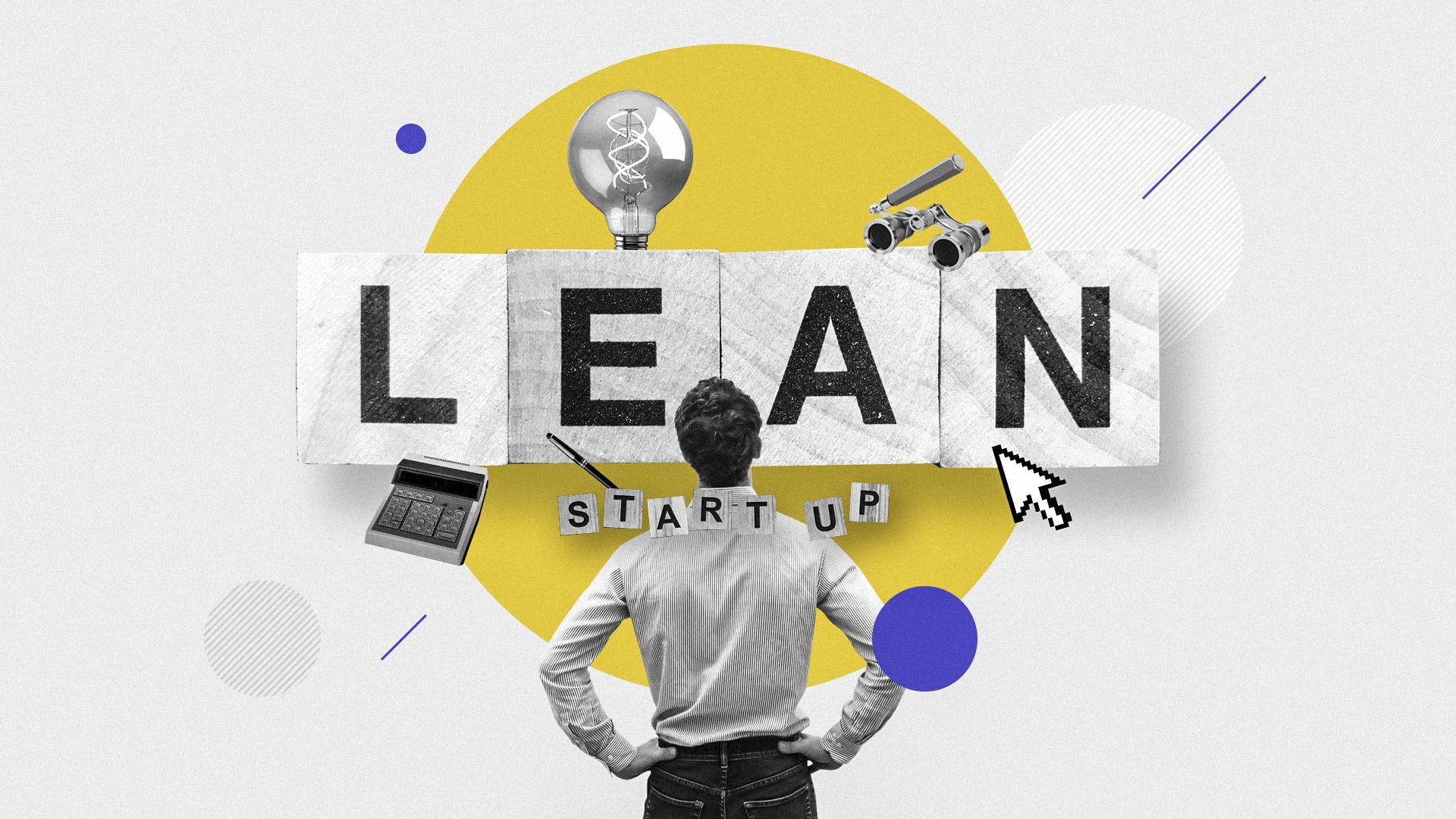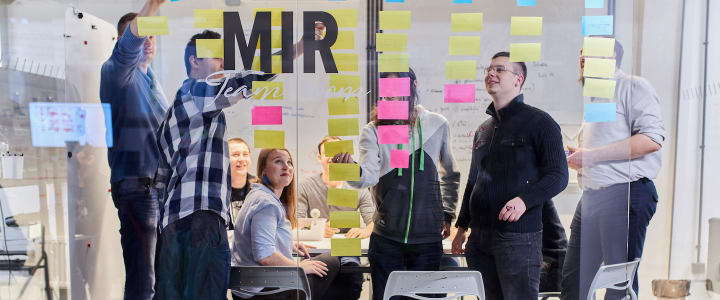What is the lean startup methodology?
There are plenty of companies who can build you an app or any other software-related product. Nonetheless, the challenge is to develop a solution that really meets the market requirements. This is when the lean startup methodology, a set of tools and processes that align your development efforts with customer needs, comes to the rescue. This article is an introduction to the lean startup methodology, its features and benefits, and its suitability for use in any digital setup.

Table of contents
In digital product development terms, the lean startup methodology gets you from point A to point B in the shortest possible time, using the shortest possible route, all the while checking that point B is really the most suitable destination. And if it isn’t, the lean startup methodology will help you identify a new and better point B.
At Boldare, with 17 years (and counting) of digital product design and development under our belts, we remain committed to using the lean startup methodology for the websites, apps, platforms and any other digital product that we create. With a strong focus on user and client needs and, most importantly, developing products that meet those needs, the lean startup methodology enables us to work rapidly, testing ideas and hypotheses at the earliest possible stage, and then pivoting each project where necessary to home in on the perfect product.
What is lean startup methodology?
First of all, the lean startup methodology is not just for startups. Yes, it was designed and developed with new, innovative, entrepreneurial digital businesses in mind but its applications have long since transcended that particular business niche.
The methodology was first presented in Eric Ries’ 2008 book, “The Lean Startup” and has been one of the most widely used and popular such methodologies for the last decade or so. The key is adopting a specific user-centered mindset and approach to the development of digital products. This lean approach is based on five principles:
- Entrepreneurs are everywhere – The lean startup methodology is entrepreneurial by nature but it’s not just for the stereotypical lone wolf new business owner. In fact, in lean startup, ‘entrepreneur’ is more of an attitude than a specific role. You’re looking to create something new and put it into the hands of those who will find it useful; you can do that as a ‘lone wolf’ or as a member of a team inside a large corporation.
- Entrepreneurship is management – Like many other endeavors, entrepreneurship is hardly an off-the-shelf, cookie-cutter process. Instead, it responds to circumstances, feedback, changing priorities… and as such, it requires management.
- Validated learning – Do you build your dream, release it into the wild (i.e. the market) and expect it to succeed? Or, do you test each of your key, innovative ideas, with your target customers, and then listen to their feedback to make the final design better? The lean startup methodology is about experimentation… and paying attention to what the results of your experiments tell you.
- Innovation accounting – If you want to know you’re making progress, you need to measure it and for that, you need the right metrics. Lean startup avoids traditional performance measures such as ROI or market share, instead focusing on creating relevant metrics under three main headings: customer focus (i.e. how you engage with customers and users), ‘leap of faith’ assumptions (i.e. checking your project and product assumptions against the reality in order to clarify the product’s market fit.
- The Build-Measure-Learn cycle – This simple cycle lies at the heart of the lean startup methodology and is the basic approach to testing your assumptions and honing your product: You build the minimum possible product to test a specific idea (it may be a version with just a single feature or function) and test it with potential customers; you measure and analyse the feedback and data you get back from the test; you apply the conclusions and learning to the next version of the product. And repeat.
Which leads us to the importance of feedback…
The (central) importance of feedback
The lean startup methodology is synonymous with feedback – whatever method you’re using, if there’s no feedback, it’s not lean startup.
The idea behind the experimentation and testing ideas and features early with customers is efficiency – to avoid the waste that comes with building a full product only to find that it doesn’t meet the needs of the people you designed it for. Frequent rounds of testing and feedback feed into the design process – build-measure-learn, remember? – and end up mapping out a more direct route to a successful product (even if it’s not exactly what you thought you’d be building when you started out). That can’t happen without user and customer feedback.
The benefits of using the lean startup methodology
At Boldare, we are convinced (or to put it another way, we have been convinced by our experience building hundreds of digital products) that the lean startup methodology leads to a better product, quicker. But what about the other benefits of working within this method?
- Less uncertainty – Creating a new digital product is often a step into the unknown. You don’t have past performance data to guide you. You have a new idea and want to make it real. The temptation may be to just dive in and do it; accept the initial lack of certainty. But the lean startup methodology gives you a framework to create certainty: clear goals, specific hypotheses, targeted testing and feedback… By reviewing at each stage (after each round of feedback) you can be sure of the next step.
- More efficiency – The lean startup methodology makes digital product development less of a gamble. The structured process, together with the testing and feedback, means you’re not just ‘putting everything on red’ and spinning the wheel. Instead, you are quickly but carefully testing each major element of your future product, ensuring that each step or phase is both necessary and working before you move on. This is a smart use of your time and resources. Furthermore, by involving potential customers from the go, you’re also building audience expectations and interest in your upcoming product,
- A successful business? – It’s possible that the biggest benefit of the lean startup methodology is a successful business. We’ve all read the terrible statistics around the success rate of startups (e.g. around 50% of new US companies fail within five years; and 70% within ten years. Source: statisticbrain.com). By creating structure, increasing efficiency and reducing waste, the lean startup methodology can be a survival tactic.
Minimum viable products (MVP)
As mentioned, a principle of the lean startup methodology is testing features with users; in fact, it is an absolutely user-centered process in that without user feedback, the process doesn’t (can’t) work. What exactly is it you’re putting in users’ hands for testing? Usually, a minimum viable product: an MVP.
The minimum viable product is just what it sounds like: a bare minimum version of your product with just the feature or features that you’re looking to test with users. Creating and testing the full product is expensive and time-consuming. And if that full product needs refining (it will!) then you have more changes to make, requiring yet more time and effort. What’s more, often some of the features you would have done differently in the first place if only you’d had earlier feedback. Testing an MVP with just the features you’re focused on in that moment can virtually eliminate wasted effort from your digital product development – even if you’ve designed an MVP with features you end up not using at all, the testing process has given you valuable information, allowing you to pivot the process in the right direction.
Remember, you’re creating a new product and though you might think you have a pretty good idea, you cannot really know what the final version will look like until you begin work. The lean startup methodology enables you to arrive at that final version as efficiently as possible.
Lean startup methodology Q&A
1. What is lean startup?
The lean startup methodology is an approach to creating digital products, allowing you to efficiently test and develop features and business ideas by working directly with the product or business’s intended end users.
2. Can a lean startup operate inside a large company?
Absolutely. The word “startup” doesn’t have to refer to a small or new business focused on innovation (the classic startup). Lean startup is more of a design framework and philosophy and can be implemented within a larger organization.
Is a lean startup only for startups?
Nope. Although the methodology was originally inspired by and designed for startups, any size of organization or company can use lean startup methods and techniques.
Is a lean startup only for big companies?
No, it’s far more flexible and adaptable than that. The lean startup methodology was conceived with small, entrepreneurial, new businesses with a focus on innovation and design. Size is not important, the process is.
Does “lean” mean cheap or quick? Or neither?
Whether your digital product development project is “cheap” or “quick” depends at least partly on what it is you’re developing. Large, complex products are unlikely to be cheap and quick, whatever process methodology you use. However, it’s practically guaranteed that using the lean startup methodology will mean your project is cheaper and quicker than if you don’t.
Summary
Over the last decade and more, the lean startup methodology has driven a break with past thinking. If you think about the build-measure-learn cycle with its testing, feedback, and pivot elements, it’s clear that rather than answer the question, How do I build this product?, lean startup enables you to ask, Should I build this product? And if the answer is, No, you shouldn’t, lean startup gives you a process to find and build the product you should be developing.
Share this article:









